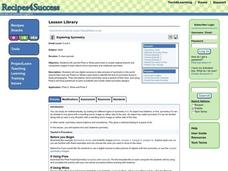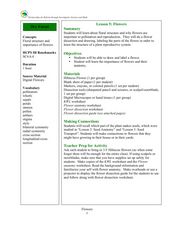Curated OER
Symmetry
Students explore symmetry. In this geometry lesson, student identify and define bilateral symmetry, radial symmetry, pentagonal symmetry, hexagonal symmetry, and cubic symmetry. Students construct examples of these types of symmetry and...
Curated OER
Reflections of Symmetry
Students use video and the Internet to identify examples of bilateral and radial symmetry in the world around them. They create symmetrical reflection designs using pattern blocks and paper.
Curated OER
Exploring Symmetry
Students use a software program to create artwork and to manipulate images to study mirror and rotational symmetry. They take pictures of items in their environment in which they identify symmetry.
Curated OER
Science and Math Lab (Students Look at Symmetry in Nature)
Students study patterns. In this symmetry in nature lesson, students examine objects to determine what type of symmetry they have. They work in small groups to rotate through stations that have objects for them to study.
Curated OER
Invertebrate Phyla
Learners explore the invertebrate phyla. They discuss the characteristics of the invertebrate Phyla in the Kingdom Animal. Students classify organisms into Phyla based on their characteristics. They distinguish radial symmetry, bilateral...
Curated OER
Invertebrates
Students examine invertebrates. In this animal classification lesson, students discuss invertebrates and bilateral symmetry. They discuss the importance of horse shoe crabs in medical science.
Curated OER
Gardens Under the Sea: Coral Reefs
Students, with dive partners, explore coral reefs through scuba diving. They also explore radial symmetry and bilateral symmetry.
Curated OER
Tackling Taxonomy
Students study physical characteristics of separate phyla and place them into similar groups. This lesson is part of a multi-segmented unit on the diversity of life. students develop a classification system by grouping animals into...
Curated OER
Comparing and Contrasting
Young scholars practice compare and contrast skills. In this science and language development lesson, students complete a T chart generating traits of a snail and a clam. Young scholars complete a related worksheet.
Curated OER
Keeping Us in Stitches Activity: Hexagon Quilt Top Design
Students examine how the hexagon shape can be a building block for quilt patterns. They view images of quilts, discuss symmetry and design patterns, and create and name an original quilt design.
Curated OER
Animal Characteristics
Allow your students to review what they learned about animal characteristics with this PowerPoint. This slideshow includes 9 multiple choice questions and an answer key at the end. Tip: You can use this as an assessment by having your...
Asian Art Museum
Create Your Own Samurai (Breastplate) Armor
Your class is going to love this activity. They get out their rulers, cardboard, and paints as they make Samurai breastplates. The simple art lesson lends itself to many different subjects such as, math/measurement, world history, and...
Curated OER
Using a Dichotomous Key for Invertebrate Phyla
Students use a key to determine the phyla of invertebrates. They are broken into groups and each group gets a stack of pictures and uses the key to determine which phyla the animal belongs to. There are also individual questions for...
Curated OER
Classification of an Echinoderm
Students study starfish through dissection. In this biology lesson plan, students explore the lives of starfish as they view a slide show, observe parts of echinoderms, and compare the classification of the starfish with other...
Curated OER
Dry Forest: Flowers
Pupils explore botany by examining diagrams. In this plant reproduction lesson plan, students define a list of plant vocabulary terms and identify plant anatomy from a diagram. Pupils complete several plant activity worksheets and study...
Curated OER
Classification of Intertidal Organisma
Students categorize animals. In this animal classification lesson plan, students group animals by their characteristics. Students break into groups and work together to classify the animals. Students fill out a graphic organizer with...















